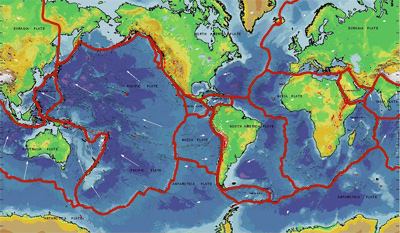This image is a cross section through the Earth showing the convection cells of the mantle. Ridge push happens at spreading centers where plates are moving apart. Slab pull happens at subduction zones where one plate is pulled down into the mantle.
Windows Original after Northcott
How Do Plates Move?
Plates at our planet’s surface move because heat in the Earth’s core causes molten rock in the mantle layer to flow. We used to think the Earth’s plates just surfed on top of the moving mantle, but now scientists believe that plates help themselves to move.
How can plates help themselves move instead of just surfing along? Just like convection cells, plates have warmer, thinner parts that rise, and colder, denser parts that sink. New parts of a plate rise because they are warm and thin, pushing the rest of a plate out of its way at spreading ridges . Old parts of a plate sink down into the mantle at subduction zones because they are colder and thicker than the warm mantle underneath them.
Last modified May 21, 2008 by Lisa Gardiner.
You might also be interested in:

Many forces change the surface of the Earth over time. The largest force that changes our planet's surface is movement of Earth's outer layer in a process called plate tectonics. As shown in this picture,
...more
When two sections of the Earth's crust collide, one slab of lithosphere can be forced back down into the deeper regions of the Earth, as shown in this picture. The slab that is forced back into the Earth
...more
Ash is formed as a volcano erupts when rocks made by the volcano blow apart into millions of tiny pieces. The rocks are still very hot, because they just formed from lava. If the hot rocks come into contact
...more
Cinder cones are simple volcanoes which have a cone shape and are not very big. Compare the size of this volcano to the strato-volcano in this image. They are usually made of piles of lava, not ash. During
...more
Lava can move in two ways, wide flat lava flows, or through channels which squeeze the lava into a small area. The fastest lava flows move at about 6 mi/hr, an easy jog, but they average between 2/3 and
...more
Plates at our planet’s surface move because heat in the Earth’s core causes molten rock in the mantle layer to flow. We used to think the Earth’s plates just surfed on top of the moving mantle, but now
...more
Many kinds of surface features are clues to a sliding lithosphere. Two types of features can form when plates move apart. At ocean ridges, the crust splits apart to make room for molten mantle rock. Continental
...more














